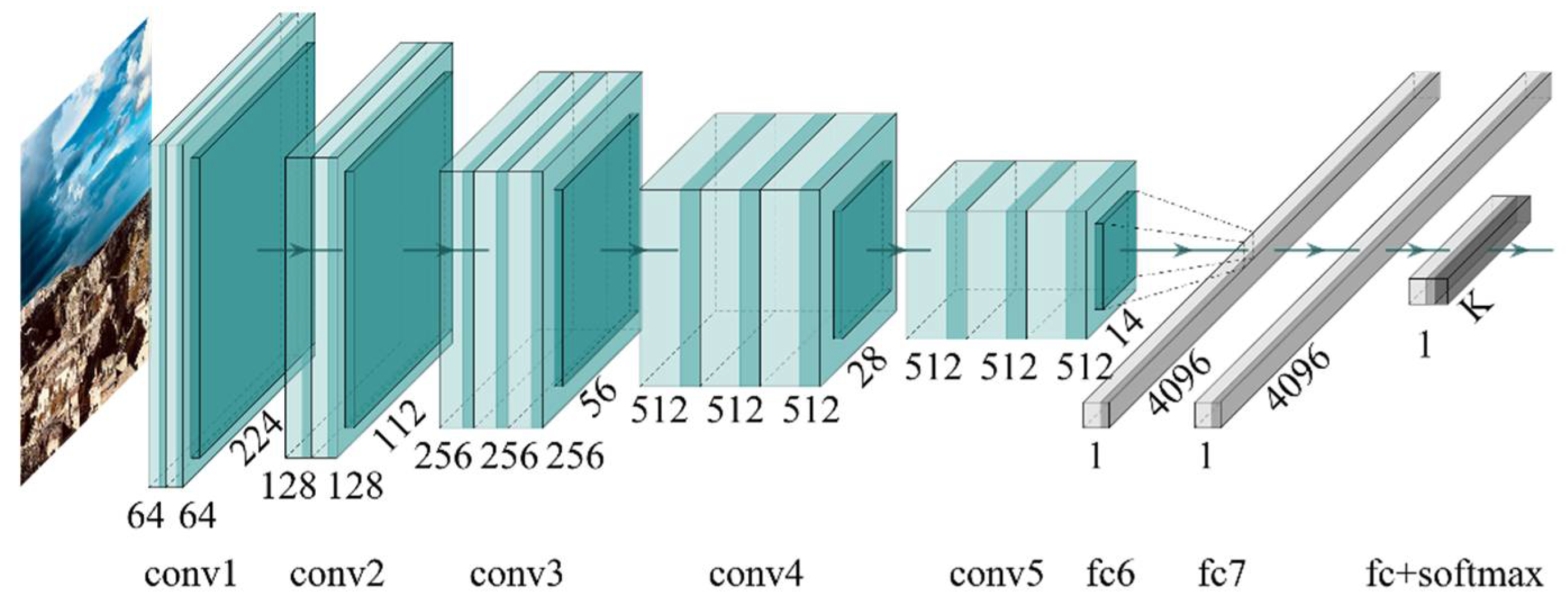Opportunistic Rainfall Monitoring from Single Pictures Using Artificial Intelligence †
Abstract
1. Introduction
2. Materials and Methods
2.1. Rainfall and Computer Vision
- Detection task: the CNN descries rainfall presence through a binary classification;
- Estimation task: the CNN estimates the quasi-instantaneous rainfall intensity through a multi-class classification;
2.2. Dataset and Model Setup
3. Results
4. Discussion—Conclusions
Author Contributions
Funding
Institutional Review Board Statement
Informed Consent Statement
Data Availability Statement
Acknowledgments
Conflicts of Interest
References
- EM-DAT|OFDA/CRED International Disaster Database. Available online: www.emdat.be (accessed on 15 April 2022).
- Myhre, G.; Alterskjær, K.; Stjern, C.W.; Hodnebrog, Ø.; Marelle, L.; Samset, B.H.; Sillmann, J.; Schaller, N.; Fischer, E.; Schulz, M.; et al. Frequency of Extreme Precipitation Increases Extensively with Event Rareness under Global Warming. Sci. Rep. 2019, 9, 16063. [Google Scholar] [CrossRef] [PubMed]
- Fletcher, T.D.; Andrieu, H.; Hamel, P. Understanding, Management and Modelling of Urban Hydrology and Its Consequences for Receiving Waters: A State of the Art. Adv. Water Resour. 2013, 51, 261–279. [Google Scholar] [CrossRef]
- McCabe, M.F.; Rodell, M.; Alsdorf, D.E.; Miralles, D.G.; Uijlenhoet, R.; Wagner, W.; Lucieer, A.; Houborg, R.; Verhoest, N.E.C.; Franz, T.E.; et al. The Future of Earth Observation in Hydrology. Hydrol. Earth Syst. Sci. 2017, 21, 3879–3914. [Google Scholar] [CrossRef] [PubMed]
- Albano, R.; Sole, A. Geospatial Methods and Tools for Natural Risk Management and Communications. ISPRS Int. J. Geo-Inf. 2018, 7, 470. [Google Scholar] [CrossRef]
- Garg, K.; Nayar, S.K. Vision and Rain. Int. J. Comput. Vis. 2007, 75, 3–27. [Google Scholar] [CrossRef]
- Chu, W.-T.; Zheng, X.-Y.; Ding, D.-S. Camera as Weather Sensor: Estimating Weather Information from Single Images. J. Vis. Commun. Image Represent. 2017, 46, 233–249. [Google Scholar] [CrossRef]
- Notarangelo, N.M.; Hirano, K.; Albano, R.; Sole, A. Transfer Learning with Convolutional Neural Networks for Rainfall Detection in Single Images. Water 2021, 13, 588. [Google Scholar] [CrossRef]
- Mahony, N.O.; Campbell, S.; Carvalho, A.; Harapanahalli, S.; Velasco-Hernandez, G.; Krpalkova, L.; Riordan, D.; Walsh, J. Deep Learning vs. Traditional Computer Vision. In Science and Information Conference; Springer: Cham, Switzerland, 2019; Volume 943, pp. 128–144. [Google Scholar] [CrossRef]
- Chollet, F.; Allaire, J.J. Deep Learning with R, 1st ed.; Manning Publications Co.: Greenwich, CT, USA, 2018. [Google Scholar]
- Hirano, K.; Maki, M.; Maesaka, T.; Misumi, R.; Iwanami, K.; Tsuchiya, S. Composite Rainfall Map from C-Band Conventional and X-Band Dual-Polarimetric Radars for the Whole of Japan. In Proceedings of the ERAD 2014—8th European Conference on Radar in Meteorology and Hydrology, Garmisch-Partenkirchen, Germany, 5–7 September 2014. [Google Scholar]
- Simonyan, K.; Zisserman, A. Very Deep Convolutional Networks for Large-Scale Image Recognition. arXiv 2014, arXiv:1409.1556. [Google Scholar] [CrossRef]

| Metric 1 | Binary Model 2 | Multiclass Model | Reference Values | |
|---|---|---|---|---|
| Overall accuracy | 85.28% | 77.71% | worst = 0% | |
| 85.13% | best = 100% | |||
| F1 score | 0.8600 | 0.73 3 | worst = 0 | |
| 0.8482 | best = 1 | |||
| Cohen’s kappa | 0.7057 | 0.7095 | worst = 0 | |
| 0.6669 | best = 1 | |||
Publisher’s Note: MDPI stays neutral with regard to jurisdictional claims in published maps and institutional affiliations. |
© 2022 by the authors. Licensee MDPI, Basel, Switzerland. This article is an open access article distributed under the terms and conditions of the Creative Commons Attribution (CC BY) license (https://creativecommons.org/licenses/by/4.0/).
Share and Cite
Notarangelo, N.M.; Hirano, K.; Albano, R.; Sole, A. Opportunistic Rainfall Monitoring from Single Pictures Using Artificial Intelligence. Environ. Sci. Proc. 2022, 21, 35. https://doi.org/10.3390/environsciproc2022021035
Notarangelo NM, Hirano K, Albano R, Sole A. Opportunistic Rainfall Monitoring from Single Pictures Using Artificial Intelligence. Environmental Sciences Proceedings. 2022; 21(1):35. https://doi.org/10.3390/environsciproc2022021035
Chicago/Turabian StyleNotarangelo, Nicla Maria, Kohin Hirano, Raffaele Albano, and Aurelia Sole. 2022. "Opportunistic Rainfall Monitoring from Single Pictures Using Artificial Intelligence" Environmental Sciences Proceedings 21, no. 1: 35. https://doi.org/10.3390/environsciproc2022021035
APA StyleNotarangelo, N. M., Hirano, K., Albano, R., & Sole, A. (2022). Opportunistic Rainfall Monitoring from Single Pictures Using Artificial Intelligence. Environmental Sciences Proceedings, 21(1), 35. https://doi.org/10.3390/environsciproc2022021035









